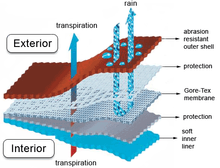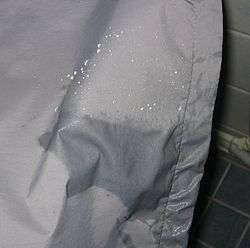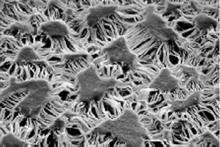Gore-Tex
Gore-Tex is a waterproof, breathable fabric membrane and registered trademark of W. L. Gore and Associates. Invented in 1969, Gore-Tex is able to repel liquid water while allowing water vapor to pass through, and is designed to be a lightweight, waterproof fabric for all-weather use. It is composed of stretched polytetrafluoroethylene (PTFE), which is more commonly known as the generic trademark Teflon.
History
 | |
|
|
Gore-Tex was co-invented by Wilbert L. Gore and Gore's son, Robert W. Gore.[1] In 1969, Bob Gore stretched heated rods of polytetrafluoroethylene (PTFE) and created expanded polytetrafluoroethylene (ePTFE). His discovery of the right conditions for stretching PTFE was a happy accident, born partly of frustration. Instead of slowly stretching the heated material, he applied a sudden, accelerating yank. The solid PTFE unexpectedly stretched about 800%, forming a microporous structure that was about 70% air.[1] It was introduced to the public under the trademark Gore-Tex.[2]
Bob Gore promptly applied for and obtained the following patents:
- U.S. Patent 3,953,566, issued April 27, 1976, for a porous form of polytetrafluoroethylene with a micro-structure characterized by nodes interconnected by fibrils
- U.S. Patent 4,187,390, issued February 5, 1980
- U.S. Patent 4,194,041 on March 18, 1980 for a "waterproof laminate", together with Samuel Allen
Another form of stretched PTFE tape was produced prior to Gore-Tex in 1966, by John W. Cropper of New Zealand. Cropper had developed and constructed a machine for this use. However, Cropper chose to keep the process of creating expanded PTFE as a closely held trade secret and as such, it had remained unpublished.[3][4] In the 1970s Garlock, Inc. allegedly infringed Gore's patents and was sued by Gore in the Federal District Court of Ohio. The District Court held Gore's patents to be invalid after a "bitterly contested case" that "involved over two years of discovery, five weeks of trial, the testimony of 35 witnesses (19 live, 16 by deposition), and over 300 exhibits" (quoting the Federal Circuit). On appeal, however, the Federal Circuit disagreed in the famous case of Gore v. Garlock, reversing the lower court's decision on the ground, as well as others, that Cropper forfeited any superior claim to the invention by virtue of having concealed the process for making ePTFE from the public. As a public patent had not been filed, the new form of the material could not be legally recognised. Gore was thereby established as the legal inventor of ePTFE.[3]
Gore-Tex is used in products manufactured by Patagonia, L.L. Bean, Oakley, Inc., Galvin Green, Marmot, Vasque, Outdoor Research, Arc'teryx, Haglöfs and The North Face among others.
Since the expiration of the main Gore-Tex patent, several other products have come to market with similar characteristics that use similar technology.[5] As a cheaper alternative to the more expensive membranes, there are also waterproof/breathable coatings which are less durable.[6][7]
For his invention, Robert W. Gore was inducted into the U.S. National Inventors Hall of Fame in 2006.[8]
Manufacture
PTFE is made using an emulsion polymerization process that utilizes the carcinogenic fluorosurfactant PFOA,[9][10] a persistent environmental contaminant. In 2013, Gore eliminated the use of PFOAs in the manufacture of its weatherproof functional fabrics.[11]

Design
Gore-Tex materials are typically based on thermo-mechanically expanded PTFE and other fluoropolymer products. They are used in a wide variety of applications such as high-performance fabrics, medical implants, filter media, insulation for wires and cables, gaskets, and sealants. However, Gore-Tex fabric is best known for its use in protective, yet breathable, rainwear.

The simplest sort of rain wear is a two layer sandwich. The outer layer is typically nylon or polyester and provides strength. The inner one is polyurethane (abbreviated: PU), and provides water resistance, at the cost of breathability.
Early Gore-Tex fabric replaced the inner layer of PU with a thin, porous fluoropolymer membrane (Teflon) coating that is bonded to a fabric. This membrane had about 9 billion pores per square inch (around 1.4 billion pores per square centimeter). Each pore is approximately 1/20,000 the size of a water droplet, making it impenetrable to liquid water while still allowing the more volatile water vapour molecules to pass through.

Both wear and cleaning will reduce the performance of Gore-Tex clothes by wearing away the Durable Water Repellent (DWR) treatment on the surface of the fabric. The DWR prevents the face fabric from becoming wet and thus reducing breathability. However, the DWR is not responsible for the jacket being waterproof. This is a common misconception, so when the face fabric becomes soaked due to an absence of DWR, there is no breathability and the wearer's sweat will cause condensation to form inside the jacket. This may give the appearance that a jacket is leaking when it is not. The DWR can be reinvigorated by tumble drying the garment or ironing on a low setting.[12]
Gore requires that all garments made from their material have taping over the seams, to eliminate leaks. Gore's sister product, Windstopper, is similar to Gore-Tex in being windproof and breathable, but has ability to stretch and is not waterproof. The Gore naming system does not imply specific technology or material but instead specific set of performance characteristics.[13]
Other uses


Gore-Tex is also used internally in medical applications, because it is nearly inert inside the body. In addition, the porosity of Gore-Tex permits the body’s own tissue to grow through the material, integrating grafted material into the circulation system.[14] Gore-Tex is used in a wide variety of medical applications, including sutures, vascular grafts, heart patches, and synthetic knee ligaments, which have saved thousands of lives.[15] In the form of expanded polytetrafluoroethylene (E-PTFE), Gore-Tex has recently been used as membrane implants for glaucoma surgery.[16]
Gore-Tex has been used for many years in the conservation of illuminated manuscripts.[17]
Explosive sensors have been printed on Gore-Tex clothing leading to the sensitive voltammetric detection of nitroaromatic compounds.[18]
The "Gore-Tex" brand name was formerly used for industrial and medical products.[19][20]
See also
- Extended Cold Weather Clothing System
- SympaTex
- Windstopper
- Hipora
- eVent (fabrics)
References
- 1 2 "Robert W. Gore". Chemical Heritage Foundation. Retrieved October 22, 2013.
- ↑ Clough, Norman E. "Innovations in ePTFE Fiber Technology" (PDF). W. L. Gore & Associates, Inc.
- 1 2 W. L. Gore Associates v. Garlock, Inc, 721 F.2d 1540. 220 U.S.P.Q. 303 (Fed. Cir. 1983).
- ↑ Schechter, Roger; Thomas, John (2008). "16.3.2.8 First Inventor Defense". Schechter and Thomas' Intellectual Property: The Law of Copyrights, Patents and Trademarks (Hornbook Series). West Academic. ISBN 9781628105186.
- ↑ Logue, Victoria. (2005). Hiking and Backpacking. Menasha Ridge Press. p 74. ISBN 0-89732-584-2.
- ↑ "Rainwear: How It Works". REI. Retrieved January 27, 2014.
- ↑ Hostetter, Kristin. "Is Gore-Tex the Best?". Backpacker. Archived from the original on February 2, 2014. Retrieved January 27, 2014.
- ↑ "Robert W. Gore". National Inventors Hall of Fame. Retrieved September 20, 2015.
- ↑ Lehmler, HJ (2005). "Synthesis of environmentally relevant fluorinated surfactants—a review". Chemosphere. 58 (11): 1471–96. doi:10.1016/j.chemosphere.2004.11.078. PMID 15694468.
- ↑ Lau C, Anitole K, Hodes C, Lai D, Pfahles-Hutchens A, Seed J (2007). "Perfluoroalkyl acids: a review of monitoring and toxicological findings". Toxicol Sci. 99 (2): 366–94. doi:10.1093/toxsci/kfm128. PMID 17519394.
- ↑ "GORE completes elimination of PFOA from raw material of its functional fabrics" (Press release). W. L. Gore & Associates. January 10, 2014. Retrieved October 7, 2014.
- ↑ "Care Centre". W. L. Gore & Associates. Retrieved January 20, 2011.
- ↑ "Fall 2008 Fabrics and Technologies". Ames Adventure Outfitters. October 18, 2007.
- ↑ Bowden, Mary Ellen. "The Cyborg Transformed". Chemical Heritage Foundation. Archived from the original on June 12, 2016. Retrieved October 22, 2013.
- ↑ "Wilbert L. "Bill" Gore". Plastics Academy Hall of Fame. Archived from the original on April 2, 2015. Retrieved October 22, 2013.
- ↑ Wang X, Khan R, Coleman A (2015). "Device-modified trabeculectomy for glaucoma". Cochrane Database Syst Rev. 12: CD010472. doi:10.1002/14651858.CD010472.pub2. PMID 26625212.
- ↑ Singer, Hannah (1992). "The Conservation of Parchment Objects Using Gore-Tex Laminate". The Paper Conservator. 16: 40. doi:10.1080/03094227.1992.9638574.
- ↑ Chuang, Min-Chieh; Windmiller, Joshua Ray; Santhosh, Padmanabhan; Ramírez, Gabriela Valdés; Galik, Michal; Chou, Tzu-Yang; Wang, Joseph (2010). "Textile-based Electrochemical Sensing: Effect of Fabric Substrate and Detection of Nitroaromatic Explosives". Electroanalysis. 22 (21): 2511. doi:10.1002/elan.201000434.
- ↑ Roolker, W.; Patt, T. W.; Van Dijk, C. N.; Vegter, M.; Marti, R. K. (2000). "The Gore-Tex prosthetic ligament as a salvage procedure in deficient knees". Knee Surgery, Sports Traumatology, Arthroscopy. 8: 20. doi:10.1007/s001670050005.
- ↑ Grethel, EJ; Cortes, RA; Wagner, AJ; Clifton, MS; Lee, H; Farmer, DL; Harrison, MR; Keller, RL; Nobuhara, KK (2006). "Prosthetic patches for congenital diaphragmatic hernia repair: Surgisis vs Gore-Tex". Journal of pediatric surgery. 41 (1): 29–33; discussion 29–33. doi:10.1016/j.jpedsurg.2005.10.005. PMID 16410103.
External links
| Wikimedia Commons has media related to Gore-Tex. |


.svg.png)